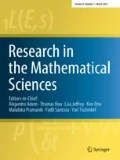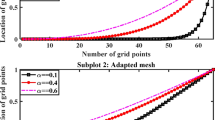Abstract
We discuss how to combine exponential time differencing technique with multi-step method to develop higher order in time linear numerical scheme that are energy stable for certain gradient flows with the aid of a generalized viscous damping term. As an example, a stabilized third order in time accurate linear exponential time differencing (ETD) scheme for the epitaxial thin film growth model without slope selection is proposed and analyzed. An artificial stabilizing term \(A\tau ^3\frac{\partial \Delta ^3 u}{\partial t}\) is added to ensure energy stability, with ETD-based multi-step approximations and Fourier pseudo-spectral method applied in the time integral and spatial discretization of the evolution equation, respectively. Long-time energy stability and an \(\ell ^{\infty }(0,T; \ell ^2)\) error analysis are provided, based on the energy method. In addition, a few numerical experiments are presented to demonstrate the energy decay and convergence rate.




Similar content being viewed by others
References
Abramov, R., Majda, A.J.: Blended response algorithms for linear fluctuation-dissipation for complex nonlinear dynamical system. Nonlinearity 20(12), 2793–2822 (2007)
Adams, R.A., Fournier, J.J.F.: Sobolev Spaces. Academic press, Singapore (2003)
Benesova, B., Melcher, C., Suli, E.: An implicit midpoint spectral approximation of nonlocal Cahn–Hilliard equations. SIAM J. Numer. Anal. 52, 1466–1496 (2014)
Beylkin, G., Keiser, J.M., Vozovoi, L.: A new class of time discretization schemes for the solution of nonlinear PDEs. J. Comput. Phys. 147, 362–387 (1998)
Canuto, C., Hussaini, M.Y., Quarteroni, A., Zang, T.A.: Spectral Methods: Fundamentals in Single Domains. Springer, Berlin (2006)
Canuto, C., Hussaini, M.Y., Quarteroni, A., Zang, T.A.: Spectral Methods: Evolution to Complex Geometries and Applications to Fluid Dynamics. Springer, Berlin (2007)
Canuto, C., Quarteroni, A.: Approximation results for orthogonal polynomials in sobolev spaces. Math. Comp. 38, 67–86 (1982)
Chen, W., Conde, S., Wang, C., Wang, X., Wise, S.M.: A linear energy stable scheme for a thin film model without slope selection. J. Sci. Comput. 52, 546–562 (2012)
Chen, W., Li, W., Luo, Z., Wang, C., Wang, X.: A stabilized second order exponential time differencing multistep method for thin film growth model without slope selection. ESAIM: M2AN 54(3), 727–750 (2020)
Chen, W., Wang, C., Wang, X., Wise, S.M.: A linear iteration algorithm for a second-order energy stable scheme for a thin film model without slope selection. J. Sci. Comput. 59, 574–601 (2014)
Chen, W., Wang, X., Yan, Y., Zhang, Z.: A second order BDF numerical scheme with variable steps for the Cahn–Hilliard equation. SIAM Numer. Anal. 57, 495–525 (2019)
Chen, W., Wang, Y.: A mixed finite element method for thin film epitaxy. Numer. Math. 122, 771–793 (2012)
Cheng, K., Feng, W., Wang, C., Wise, S.M.: An energy stable fourth order finite difference scheme for the Cahn–Hilliard equation. J. Comput. Appl. Math. 362, 574–595 (2019)
Cheng, K., Qiao, Z., Wang, C.: A third order exponential time differencing numerical scheme for no-slope-selection epitaxial thin film model with energy stability. J. Sci. Comput. 81, 154–185 (2019)
Cheng, K., Wang, C., Wise, S.M.: An energy stable Fourier pseudo-spectral numerical scheme for the square phase field crystal equation. Commu. Comput. Phys. 26, 1335–1364 (2019)
Cheng, Q., Shen, J., Yang, X.: Highly efficient and accurate numerical schemes for the epitaxial thin film growth models by using the SAV approach. J. Sci. Comput. 78, 1467–1487 (2019)
Cox, S.M., Matthews, P.C.: Exponential time differencing for stiff systems. J. Comput. Phys. 176, 430–455 (2002)
Ehrlich, G., Hudda, F.G.: Atomic view of surface self-diffusion: tungsten on tungsten. J. Chem. Phys. 44, 1039–1049 (1966)
Engquist, B., Majda, A.: Radiation boundary conditions for acoustic and elastic wave calculations. Commun. Pure Appl. Math. 32, 313–357 (1979)
Eyre, D.J.: Unconditionally gradient stable time marching the Cahn–Hilliard equation. In: MRS Online Proceedings Library Archive, Volume 529 (Symposia BB–Computational & Mathematical Models of Microstructural Evolution), p. 39 (1998)
Feng, K., Qin, M.: Symplectic Geometric Algorithms for Hamiltonian Systems. Springer, Berlin (2010)
Feng, W., Wang, C., Wise, S.M., Zhang, Z.: A second-order energy stable backward differentiation formula method for the epitaxial thin film equation with slope selection. Numer. Methods Part. Differ. Equ. 34, 1975–2007 (2018)
Feng, X., Tang, T., Yang, J.: Long time numerical simulations for phase-field problems using p-adaptive spectral deferred correction methods. SIAM J. Sci. Comput. 37, A271–A294 (2015)
Golubović, L.: Interfacial coarsening in epitaxial growth models without slope selection. Phys. Rev. Lett. 78, 90–93 (1997)
Gottlieb, D., Orszag, S.A.: Numerical Analysis of Spectral Methods: Theory and Applications. SIAM, Philadelphia (1977)
Gottlieb, S., Shu, C.W., Tadmor, E.: Strong stability-preserving high-order time discretization methods. SIAM Rev. 43, 89–112 (2001)
Gottlieb, S., Wang, C.: Stability and convergence analysis of fully discrete fourier collocation spectral method for 3-D viscous Burgers’ equation. J. Sci. Comput. 53, 102–128 (2012)
Hairer, E., Noersett, S.P., Wanner, G.: Solving Ordinary Differential Equations I: Nonstiff Problems. Springer, Berlin (1987)
Hochbruck, M., Ostermann, A.: Exponential integrators. Acta Numer. 19, 209–286 (2010)
Hochbruck, M., Ostermann, A.: Exponential multistep methods of Adams-type. BIT Numer. Math. 51, 889–908 (2011)
Jin, S.: Efficient asymptotic-preserving (AP) schemes for some multiscale kinetic equations. SIAM J. Sci. Comput. 21, 441–454 (1999)
Ju, L., Li, X., Qiao, Z., Zhang, H.: Energy stability and error estimates of exponential time differencing schemes for the epitaxial growth model without slope selection. Math. Comput. 87, 1859–1885 (2017)
Ju, L., Liu, X., Leng, W.: Compact implicit integration factor methods for a family of semilinear fourth-order parabolic equations. Discrete Contin. Dyn. Syst. B 19, 1667–1687 (2014)
Ju, L., Zhang, J., Du, Q.: Fast and accurate algorithms for simulating coarsening dynamics of Cahn–Hilliard equations. Comput. Mater. Sci. 108, 272–282 (2015)
Ju, L., Zhang, J., Zhu, L., Du, Q.: Fast explicit integration factor methods for semilinear parabolic equations. J. Sci. Comput. 62, 431–455 (2015)
Kohn, R.V., Yan, X.: Upper bound on the coarsening rate for an epitaxial growth model. Commun. Pure Appl. Math. 56, 1549–1564 (2003)
Li, B.: High-order surface relaxation versus the Ehrlich–Schwoebel effect. Nonlinearity 19, 2581–2603 (2006)
Li, B., Liu, J.: Thin film epitaxy with or without slope selection. Eur. J. Appl. Math. 14, 713–743 (2003)
Li, B., Liu, J.: Epitaxial growth without slope selection: energetics, coarsening, and dynamic scaling. J. Nonlinear Sci. 14, 429–451 (2004)
Li, D., Qiao, Z., Tang, T.: Characterizing the stabilization size for semi-implicit Fourier-spectral method to phase field equations. SIAM J. Numer. Anal. 54, 1653–1681 (2016)
Li, W., Chen, W., Wang, C., Yan, Y., He, R.: A second order energy stable linear scheme for a thin film model without slope selection. J. Sci. Comput. 76, 1905–1937 (2018)
Li, X., Qiao, Z., Zhang, H.: Convergence of a fast explicit operator splitting method for the epitaxial growth model with slope selection. SIAM J. Numer. Anal. 55, 265–285 (2017)
Miranville, A.: The Cahn–Hilliard Equation: Recent Advances and Applications. SIAM, Philadelphia (2019)
Moldovan, D., Golubovic, L.: Interfacial coarsening dynamics in epitaxial growth with slope selection. Phys. Rev. E. 61, 6190–6214 (2000)
Qiao, Z., Tang, T., Xie, H.: Error analysis of a mixed finite element method for the molecular beam epitaxy model. SIAM J. Numer. Anal. 53, 184–205 (2015)
Qiao, Z., Wang, C., Wise, S.M., Zhang, Z.: Error analysis of a finite difference scheme for the epitaxial thin film model with slope selection with an improved convergence constant. Int. J. Numer. Anal. Mod. 14, 283–305 (2017)
Qiao, Z., Zhang, Z., Tang, T.: An adaptive time-stepping strategy for the molecular beam epitaxy models. SIAM J. Sci. Comput. 33, 1395–1414 (2011)
Schwoebel, R.L.: Step motion on crystal surfaces. II. J. Appl. Phys. 40, 614–618 (1969)
Shen, J., Tang, T., Wang, L.: Spectral Methods: Algorithms, Analysis and Applications. Springer, Berlin (2011)
Shen, J., Wang, C., Wang, X., Wise, S.M.: Second-order convex splitting schemes for gradient flows with Ehrlich–Schwoebel type energy: application to thin film epitaxy. SIAM J. Numer. Anal. 50, 105–125 (2012)
Shen, J., Xu, J., Yang, J.: The scalar auxiliary variable (SAV) approach for gradient flows. J. Comput. Phys. 353, 407–416 (2018)
Tam, C.K., Webb, J.C.: Dispersion-relation-preserving finite difference schemes for computational acoustics. J. Comput. Phys. 107, 262–281 (1993)
Wang, C., Wang, X., Wise, S.M.: Unconditionally stable schemes for equations of thin film epitaxy. Discrete Contin. Dyn. Syst. 28, 405–423 (2010)
Wang, X., Ju, L., Du, Q.: Efficient and stable exponential time differencing Runge–Kutta methods for phase field elastic bending energy models. J. Comput. Phys. 316, 21–38 (2016)
Xu, C., Tang, T.: Stability analysis of large time-stepping methods for epitaxial growth models. SIAM J. Numer. Anal. 44, 1759–1779 (2006)
Yang, X., Zhao, J., Wang, Q.: Numerical approximations for the molecular beam epitaxial growth model based on the invariant energy quadratization method. J. Comput. Phys. 333, 104–127 (2017)
Zhu, L., Ju, L., Zhao, W.: Fast high-order compact exponential time differencing Runge–Kutta methods for second-order semilinear parabolic equations. J. Sci. Comput. 67, 1043–1065 (2016)
Zhang, Z., Qiao, Z.: An adaptive time-stepping strategy for the Cahn–Hilliard equation. Commun. Comput. Phys. 11, 1261–1278 (2012)
Acknowledgements
This work is supported in part by the Grants NSFC 11671098, 91630309, a 111 Project B08018 (W. Chen), NSF DMS-1418689 (C. Wang), NSFC11871159, Guangdong Provincial Key Laboratory for Computational Science and Material Design 2019B030301001 (X. Wang). C. Wang also thanks the Key Laboratory of Mathematics for Nonlinear Sciences, Fudan University, for support during his visit.
Author information
Authors and Affiliations
Corresponding author
Additional information
Dedicated to Professor Andrew Majda on the occasion of his seventieth birthday.
Publisher's Note
Springer Nature remains neutral with regard to jurisdictional claims in published maps and institutional affiliations.
Rights and permissions
About this article
Cite this article
Chen, W., Li, W., Wang, C. et al. Energy stable higher-order linear ETD multi-step methods for gradient flows: application to thin film epitaxy. Res Math Sci 7, 13 (2020). https://doi.org/10.1007/s40687-020-00212-9
Received:
Accepted:
Published:
DOI: https://doi.org/10.1007/s40687-020-00212-9
Keywords
- Gradient flow
- Epitaxial thin film growth
- Exponential time differencing
- Long-time energy stability
- Convergence analysis
- Third-order scheme




